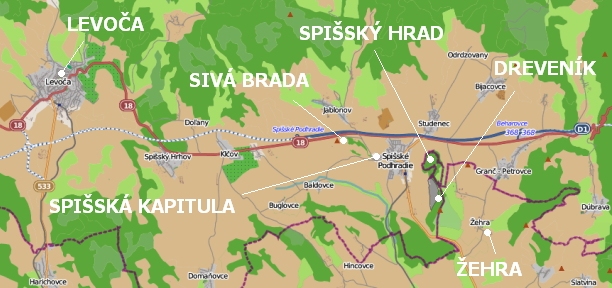Spis Castle
November – March CLOSED
May – September OPEN DAILY 09:00 – 18:00 (April, October 09:00 – 16:00)
SPIS CASTLE IS OPEN, BUT ONLY MIDDLE AND LOWER COURTYARD.
middle and lower courtyard + upper castle (included guided tours GB/ D and audio guides GB/ D/ PL/ HU/ SK)
08,00 EUR basic admission
06,00 EUR students (19-26 years old of age), seniors
04,00 EUR children (6-18 years old of age)
19,00 EUR family (maximum of 4 persons)
middle and lower courtyard
06,00 EUR basic admission
04,00 EUR children, students, seniors
nocturnal tours (july, august/ saturday/ 20:30 o´clock/ Slovak language; for English call 00421 (0)53 454 1336)
10,00 EUR basic admission
08,00 EUR reduced admission (children under the 18 old of age, students, seniors)
25,00 EUR family (maximum of 4 persons)
(children under the 6 years old of age, seniors up of 80 years and journalists free admission)
Zehra
Spisska Kapitula
Levoca

More than 800 years ago the monumentous stone castle had started to rear up imperiously about the sea level of 634 metres. In year the 1780 a great fire undewrote its final indelibe demolition. The castle ruins together with unique environs of Spis territory is since 1993 registered in UNESCO’s World Cultural and Natural Heritage List.
The Spis Castle hill is unique locality. As early as the Neolithic humen transmited to posterity traces as old as almost 7 thousand years. Even much early before the neolithic man moved about these region. The human skeleton relics and money bag near by with the coins from period of two thousand years ago, of Celtic Kotin tribe period were lately found in the cave under castle.
The first of all what raised on high reef before 800 years was monument defense and residential tower Donjon. The one who initiated all, was the king Bela III. Perhaps the qeen. It was built out of spis travertine. However soon it collapsed. Presumably it was result of tectonic disturbances and followed movement of the rocky base.
The entrance into the new fortified unity was equipped by Romanesque gate with the portcullis and the pitch rib. The romanesque palace and the new tower, tower „Don’t be afraid“ (Nebojsa) erected inside. Preserved documents doesn’t give out if residents had really always felt themselves safe there.
Among the Mongols they did not have to resist. Were the Mongols ever at the Spis region? Today no one can easily say, even if the castle hadn’t interested them. It seems that castle have became present extent that gasp for ones breath after Mongols arivel from kingdom. However the castle have appealed to the spis prior, which comitted himself to take care of the castle, and his recompense was alowance for living himself there.
Just in case a Nomads would really appear… He let to built his own residence before the entrance into the upper castle. The new coutyard with habitable tower from where the Romanesque chapelle was reached by gallery. He let built thus right in front of spis count, royal governor of Spis, habitating the romanesque palace at the castle acroppolis.
Finaly the prior had changed the castle living for fortyfied chapter residence on the hill nearby. Fortunately or unfortunately, king Sigismundus was brave more than residents of the town under the castle, the castle itself wasn’t ever sold out for the debts. As well as the Spis Chapter nor priors living hadn’t fell into polish lender’s lot.
Perhaps a Gipsy princes dedicated more than one charming look during one night, that legend says. She helped to her fellows awaited under castle sneak in, why she wouldn’t gain more? A lot of counts took turns there, every now and then, some kings stoped by and whosoever a besiegers and those, who would have to besiege the castle, finaly castle had been depressed.
After all in the year 1780, last but not least fire flames troded from the castle to sky instead of towers. Fire. The enemy number one. Even Csáky family, the last owners themselves set devastating wound to the castle. The castle itself became supply of a building material for a new built manor-houses at the castle surroundings. The social people followed model of their counts.

GPS súradnice: 48°59’58.000″ N, 20°46’3.000″ E
